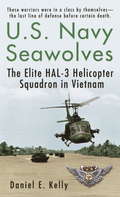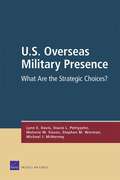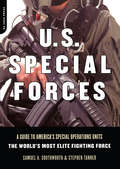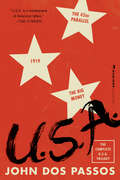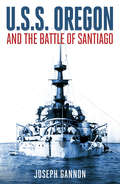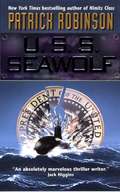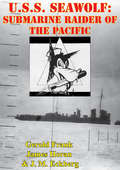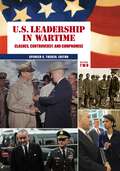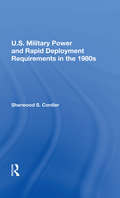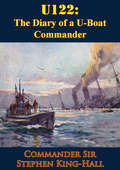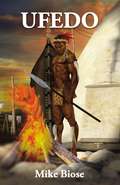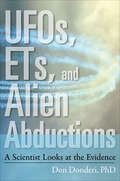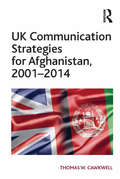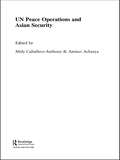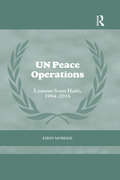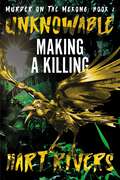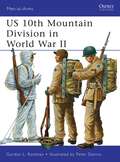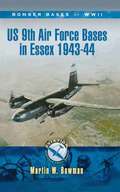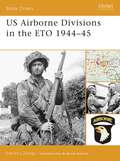- Table View
- List View
U.S. Navy Seawolves
by Daniel E. KellyThere were no dry runs for Seawolves in Vietnam. They put their lives on the line--every time. In the Viet Cong-infested Mekong Delta, where small SEAL teams were always outgunned and outnumbered, discovery brought swift, deadly consequences-- and a radio call for backup from the United States Navy's very best: the Seawolves. The whir of approaching rotor blades signaled their arrival as they tore through the jungle at treetop level, gunners hanging off the skids, shooting M-60s, raining down their lethal mix of high explosives and incendiary death. Seawolf Dan Kelly describes the origins of this extraordinary outfit. Put through a training program unlike any other, these men emerged to perform unparalleled feats of courage. The stories of these elite warriors capture America's real heroes in all their guts and glory, and demonstrate why the Seawolves are known as the most successful and most decorated unit in the Vietnam War.
U.S. Overseas Military Presence: What Are the Strategic Choices?
by Lynn E. Davis Stacie L. Pettyjohn Melanie W. Sisson Stephen M. Worman Michael J. McnerneyThe role of the United States and its global military presence are under debate in the face of changing strategic and economic realities. The authors present a menu of global postures and compare them in terms of the U. S. Air Force bases, combat forces, active-duty personnel, and base operating costs. Ultimately, the choice will depend on perspectives on the role overseas military presence can play in achieving U. S. global security interests.
U.S. Special Forces: A Guide To America's Special Operations Units -- The World's Most Elite Fighting Force
by Stephen Tanner Samuel A. SouthworthPresident George W. Bush has told all Americans that the war against terrorism would be like no other war. But what does this mean? Who will fight? How will they fight? What weapons will be used? Most informed commentators agree that the war against terrorism will be fought largely by "special forces"-that is, by a relatively new community within the American military known as Special Operations Forces, or SOF's. This new "branch" of the armed forces was created in the mid-1980s and is organized under its own unified command, called U. S. Special Operations Command (SOCOM). Consisting of special units from the other branches of the armed forces, such as Green Berets, Rangers, SEALs, and Delta Force, this new fighting command is recognized internationally as the most well-trained and well-equipped special operations force in the world. Their missions are varied-including combat terrorism, search and rescue, reconnaissance, humanitarian assistance, peacekeeping duty, and conventional and unconventional warfare. Despite special forces’ international reputation for excellence, Americans know little about this remarkable fighting force. U. S. Special Forces provides a handy and comprehensive compendium, including descriptions of the units and their operational specialties, training, and organization, as well as the equipment and technological gadgetry, weapons, armor, planes, helicopters, and support vehicles used by each unit.
U.S. Special Operations Forces in the Philippines, 2001–2014
by Linda Robinson Gillian S. Oak Patrick B. JohnstonThis report examines the 14-year experience of U.S. special operations forces in the Philippines from 2001 through 2014 and the activities and effects of special operations capabilities employed to address terrorist threats in Operation Enduring Freedom--Philippines through training and equipping Philippine security forces, providing operational advice and assistance, and conducting civil-military and information operations.
U.S. Special Warfare: The Elite Combat Skills of America's Modern Armed Forces
by Samuel A. SouthworthFor many centuries, the job of everyday soldiers, the "grunts," was the same-"see the hill, take the hill. " But the combat role of today's U. S. soldier has undergone a radical change. <P><P>The recent revolution in the art of soldiering in America emphasizes a smaller, but more highly specialized and technologically equipped, armed force. Now, even everyday soldiers in America's armed forces specialize in elite combat skills that use the very latest high-tech equipment. After basic training, many of today's recruits continue advanced training in one of the new emerging combat specialties, such as urban, mountain and arctic warfare; amphibious, underwater and small boat operations; modern cavalry combat; sniping; military intelligence and psychological warfare; search and rescue procedures, and combat engineering. In lively and entertaining prose, military historian Sam Southworth describes these emerging combat specialties-as well as the training and equipment for each-that characterize America's fighting force today.
U.S.A.: The Complete Trilogy [The 42nd Parallel, 1919, and The Big Money] (U.S.A. Trilogy #3)
by John Dos PassosU.S.A. has descriptive copy which is not yet available from the Publisher.
U.S.S. Oregon and the Battle of Santiago
by Joseph C. GannonThe U.S.S. Oregon and the Battle of Santiago, first published in 1958, is an eyewitness account of the famous Spanish-American War sea battle off the coast of Cuba in 1898. Written by crewmember Joseph Gannon, the book describes the Oregon's long voyage of nearly 16,000 miles from Bremerton, Washington, to Peru, around Cape Horn at the southern tip of South America (the Panama Canal was not yet built), Rio de Janeiro (where the ship learned that war with Spain had been declared), and finally on to the Caribbean (where Gannon joined the ship's crew) as part of the blockade fleet on Cuba. On July 3, 1898, the Oregon and the cruiser Brooklyn were the only two ships fast enough to chase down the Spanish cruiser Cristóbal Colón, forcing its surrender. The Oregon's successful long voyage and performance in the war earned her the nickname of “the Bulldog.” Also, the length of the voyage around the Americas, requiring more than two months, bolstered public support for the construction of the Panama Canal. The Oregon would go on to serve in the Philippines, China, World War I, and her stripped hull was used in World War II at Guam as an ammunition barge. Included are a ship's roster and 7 pages of illustrations.
U.S.S. Seawolf (Arnold Morgan #4)
by Patrick RobinsonArmed with stolen U.S. military technology, the Chinese are producing a frightening new breed of weaponry,led by the ICBM submarine Xia III -- a vessel that just might be able to launch a nuclear warhead across the Pacific Ocean and take out an American West Coast city. National Security Adviser Admiral Arnold Morgan can't let that happen, and he dispatches the most stealthy hunter-killer submarine in the U.S. fleet, the 9,000-ton ultrasecret Seawolf, deep into the dark, forbidden waters of the South China Sea. But then the unthinkable happens: Seawolf, collides with a Chinese destroyer and falls into enemy hands. A team of cunning Navy SEALs -- the biggest Special Forces assault group assembled since Vietnam -- is sent in to free the captive Seawolf, crew and bring them home. The American Eagle confronts the Chinese Dragon with the balance of world power on the line. Failure is not an option...
U.S.S. Seawolf: Submarine Raider Of The Pacific [Illustrated Edition]
by Gerold Frank J. M. Eckberg James David HoranIllustrated with 16 photos of the ship and crewWriters Gerold Frank and James Horan were struck by their travelling companion on a train between New York and New London, Conneticut in 1943; "He was big and brawny, his giant frame squeezed into a coach seat; he had the clear blue eyes, the hawklike gaze of a Viking; and he was the most beribboned figure we had ever seen in a navy uniform". This man was Chief Radio Operator Jim Eckberg, and as he told Frank and Horan the tale of his ship, the famous USS Seawolf, they were captivated and determined to write a book commemorating the heroic actions of the crew and so "U.S.S. Seawolf: Submarine Raider Of The Pacific" was born.With the expert aid of Eckberg, the authors set about to recreate the history and atmosphere aboard the sub. Her career started slowly; during her first two forays around Manila in 1942 she could not get a clean target and was depth charged for the first time. Her luck changed in February 1942, roaming in the Java Sea, she struck her first live target and so would begin a game of cat and mouse with the Imperial Japanese Navy for months to come. Aggressively handled, stealthy and quick to dive to avoid the inevitable depth charge reprisals, the Seawolf would leave a trail of destruction in here wake until January 1943 when she docked in San Francisco and took on a new crew. The Seawolf received 13 coveted battle stars during the war and sunk a confirmed 71,609 tons of Japanese shipping.An exciting, authentic and atmospheric account of the 'War Beneath the Waves' against Japan.
U.s. Leadership in Wartime: Volume 2
by Spencer TuckerPresident Harry S. Truman's 1951 firing of Douglas MacArthur ended the nation's most famous showdown between a commander in chief and a high-profile officer--but it was far from the only time a chief executive and a general clashed.
U.s. Military Power And Rapid Deployment Requirements In The 1980s
by Sherwood S CordierThis book assesses U.S. military needs in the coming decade, focusing on the role of rapid deployment forces in protecting U.S. interests abroad. Dr. Cordier begins by discussing two general developments crucial to future military requirements: first, increasing U.S. dependence on the global sea-lanes as links to key markets; and second, improved S
U122: The Diary of a U-Boat Commander [Illustrated Edition]
by Commander Sir Stephen King-Hall Lieutenant-zu-See Karl Von SchenkIncludes The First World War At Sea Illustrations Pack with 189 maps, plans, and photos."The diary (translated into English) of a World War One U-Boat commander. As well as being a fascinating glimpse of life on the German U-boats during the intense submarine blockade, this also reminds us there were humans involved - on both sides of the action - as we read too of the intimate thoughts and intense love of a man longing for his sweetheart."-Print ed.
UDT/Seal Operations in Vietnam
by T. L. BosiljevacTHEY WERE THE WEAPON OF LAST RESORT In January 1962, two Sea, Air, and Land Teams were formed. Called SEALs for short, the teams drew their name from the elements through which they infiltrate, operate, and melt away. Commissioned to operate up to twenty miles inland in enemy territory, they would act as naval commandos whose functions were to gather intelligence, raid, ambush, capture prisoners, and create havoc in enemy territory. This book recounts the many daring missions that the SEALs undertook to serve their country. It was during the Vietnam War years that their Special Warfare reputation was built, and the heroism of the few brave men detailed here shows why.
UFEDO
by Mike BioseNkemi one of the Otani warriors rescued the beautiful Uredo on her way to visit one of her aunts in Obaji and fell in love with her, during one of his visits he made a promise to see her on particular day, though it was rainy and he very sick, he still risked the visit which became very disastrous, a fisherman rescued him and took care of him and later adopted him as his son. When he became well, he eventually visited Idah with his adopted father and a day was set for the marriage rites.But those were the days that the white men had begun to come first in trickles, one of them Richard a missionary had resided in Igalla land for a while without winning a soul, just at about the time set for the marriage rites Unekwuojo Uredo&’s junior brother fell sick the marriage rites was postponed he later died, on the way to be buried at the evil forest where Richard resides, Richard prayed for the young man and he was raised from the dead, Ojomu the father of the young man became a good friend to Richard and eventually got converted and took over trying to reach his own people with the gospel.Meanwhile just some few days to the beginning of the marriage rites a ship arrived the shores of Onitsha a commercial village and blocked river ways, the ship bombarded Onitsha and the Royal Niger Company sent soldiers to the hinterlands, Nkem being a warrior joined forces with the Ekwumekmu warriors to protect his mother land from been taken over by the white men.While the war was on, Ojomu&’s conversion to Christianity brought about a turnoil in the entire Igalla land, this led to his wife and children&’s eyes been gorged out and he beheaded.After the war with the white men, when Nkem returned to his betrothed, things had taken a new turn.
UFOs, ETs, and Alien Abductions: A Scientist Looks at the Evidence
by Don Donderi“A splendid book compiling the extensive evidence justifying his courageous and clear conclusion that some UFOs are extraterrestrial spacecraft.” —Stanton T. Friedman, author of Flying Saucers and SciencePsychologist and researcher Don Donderi examines the evidence and research from the past several decades on the changing nature of UFOs. He looks at why the scientific establishment takes a dim view of UFOs and abduction evidence and examines how the US government has collected and suppressed UFO evidence.UFOs, ETs, and Alien Abductions is a wide-ranging examination of all things off-planet that falls into three sections . . . UFOs: evidence and belief between 1947 through 1965 and Cold War mysteriesThe changing nature of UFO phenomenon from 1965 to the present, which makes the case for the existence of humanoid crew members seen in and around landed UFOs. This section also examines six well-documented abduction cases, and includes the author detailing his own research involvement with the evidence. He refutes the belief that all abductees are mentally disturbed and that a psychological disturbance explains the experience.The third section is devoted to a very meaty and controversial analysis of science, politics, and UFOs.“An excellent study of the UFO phenomenon and the scientific community’s reaction to it.” —David M. Jacobs, author of The Threat: Revealing the Secret Alien Agenda“A bold summation of the case for extraterrestrial UFOs, which explains why science has rejected these data and tells us how the UFO phenomenon is potentially important for all mankind.” —Mark Rodeghier, president and scientific director of the J. Allen Hynek Center for UFO Studies
UK Communication Strategies for Afghanistan, 2001–2014
by Thomas W. CawkwellThe war in Afghanistan came to an end in 2014 after nearly thirteen years of conflict. Throughout that period, British officials have described UK operations there in various conflicting and often contradictory ways; as a counter-terrorism mission, a stabilisation mission, and a counter-narcotics mission, respectively. This book investigates how the war was ’sold’ to the British public and how Britain’s ’transnational’ foreign and defence policy impacted on the unfolding of UK strategy in Afghanistan and the way it was communicated. It argues that because the UK’s foreign and defence policy is transnationally-oriented - meaning that it is foundationally aimed at maintaining alliance with the United States and the institutional coherence of NATO - UK strategy is contingent upon collective security and, crucially, is fundamentally concerned with the means of policy (maintaining alliances) over the ends (using alliances to effect change). Explaining the inalienability of collective security systems to national security is no easy task, however, and, when faced with the adversities of Afghanistan, the UK state has since 2008 instead opted to describe the significance of Afghanistan in narrow, nation-centric, counter-terrorist concerns in order to maintain public support for collective security operations there whilst, paradoxically, framing the conflict in a manner that avoids talking about the transnational structure and purpose of the mission. This kind of ’strategic’ communication is increasingly becoming a focus of the UK state as it faces a transnational dilemma of maintaining its collective security bonds whilst facing a public increasingly sceptical of liberal interventionism.
UN Peace Operations and Asian Security
by Mely Caballero-Anthony & Amitav AcharyaThis is an unparallelled analysis of the state of the United Nations peace operations and their impact on Asian security.This new volume examines new strategies being adopted by the UN; including doctrinal shifts in peace operation, and assesses the division of labour between the UN, regional organisation and non-governmental organisations/actors. Based on selected papers from mostly Asian scholars, the book offers regional perspectives from South, Southeast and Northeast Asia on the changing nature of UN Peace operations and analyses some of the core issues that are of critical relevance to regional security in Asia. In addition it reveals interesting new insights on the new players in the area of peace operations – i.e. China and Japan and considers their projected roles as defined by their respective security concepts. It also delves into issues of possible areas of concern caused by the new activism of these regional powers in peace operations. Finally, the book also revisits the significant lessons learnt from the UN experience in Cambodia and East Timor and examines their impact on future directions of peace operations.This book was previously published as a special issue of the leading journal International Peacekeeping.
UN Peace Operations: Lessons from Haiti, 1994-2016 (Cass Series on Peacekeeping)
by Eirin MobekkThis book assesses the UN Peace Operations in Haiti and establishes what lessons should be taken into account for future operations elsewhere. Specifically, the book examines the UN’s approaches to security and stability, demobilisation, disarmament and reintegration (DDR), police, justice and prison reform, democratisation, and transitional justice and their interdependencies through the seven UN missions in Haiti. Drawing on extensive fieldwork and interviews conducted in Haiti, it identifies strengths and weaknesses of these approaches and focuses on the connections between these different sectors. It places these efforts in the broader Haitian political context, emphasises economic development as a central factor to sustainability, provides a civil society perspective, and discusses the many constraints the UN faced in implementing its mandates. The book also serves as a historical account of UN involvement in Haiti, which comes at a time when the drawdown of the mission has begun. In an environment where the UN is increasingly seeking to conduct security sector reform (SSR) within the context of integrated missions, this book will be a valuable contribution to the debate on intervention, UN peace operations and SSR. This book will be of interest to students of peace operations and peacekeeping, conflict studies, security studies and IR in general.
UNBREAKABLE: Vietnam War Psychological Thriller (Murder on the Mekong #1)
by Hart Rivers". . . a chilling and astonishing novel by authors who know their way around a story." ~Peggy Webb, USA Today bestselling authorFreshly Minted Child Psychiatrist Endures the Lost Minds, Lives and Loves of the Vietnam War in UNBREAKABLE, a Tale of Terror, Humanity and Survival by Hart Rivers-- Nha Trang, Vietnam, 1969 --Innocence is often the first casualty of war. Such is the case for Dr. Israel (Izzy) Moskowitz, drafted from his residency at Columbia University to the 99KO, the Army’s frontline psychiatric unit of the 8th Field Hospital. Having left his fiancée in New York, Izzy, along with his new friend, Dr. Gregg Kelly, is ill-prepared for the death and carnage of the horrific war that greets him.J.D. Mikel arrives at the 99KO, presumably as another "shrink" but it's quickly apparent that he's really a "spook"--the CIA's most devious spy/assassin--undercover in search of a so-called Ghost Soldier responsible for the gruesome murders of U.S. troops. He recruits the reluctant Izzy and Gregg as his assistants for their psychological expertise since there could be a military personnel nut job on the loose. Izzy--already questioning his own sanity after witnessing multiple traumatic events--realizes he must quickly find a stronger, craftier, more resilient version of himself.Along the Mekong River, amidst soldiers losing their minds, mortar attacks, death and the heat of hell's fire, Izzy, Gregg and J.D. discover the true depth of friendship in a shared quest to become UNBREAKABLE.Publisher's Note: Readers should be prepared for death and graphic violence consistent with the true nature of the Vietnam war.Previously titled as MAKING A KILLING, UNBREAKABLE is a tightly woven psychological thriller that reflects the real-world experience and knowledge of the author team.Fans of Dan Hampton, Larry Chambers, Joe Hart, Doug Stantan and Karl Marlantes will not want to miss this military historical fiction series."Smart, well-crafted, and tense!" ~The Book Review"What a roller coaster ride of a story! Impossible to put down . . . everything a page turning book should be." ~Book Bug". . . dirty and gritty, showing a not often seen side of the Vietnam War." ~Shannon GonzalezonMurder on the Mekong SeriesUNBREAKABLEBLINDSPOT (novella)UNKNOWABLEUNSPEAKABLEMeet the Authors: Hart Rivers is the pen name for bestselling co-authors John L. Hart and Olivia Rupprecht. John, creator of the Murder On The Mekong series, has been a practicing psychotherapist for over 40 years, starting in Vietnam where he was a psychology specialist. He received his doctorate from the University of Southern California, is an internationally respected lecturer, has been a consultant to the nation of Norway for their Fathering Project, and maintained a private practice in Los Angeles for twenty years. His time is divided between Hawaii--where he enjoys snorkeling, stand up paddle boarding, and is a featured artist at the Mauna Kea Hotel--and Vancouver Island, B.C., where he is an adjunct associate professor at the University of Victoria in British Columbia.Olivia is an award-winning author whose novels have sold worldwide, and Series Developer of True Vows, the groundbreaking series of reality-based novels from HCI Books. She lives in a historic tavern on a lake in Wisconsin.
UNKNOWABLE: Vietnam War Psychological Thriller (Murder on the Mekong #2)
by Hart Rivers". . . suspenseful and exciting, gritty and dark . . .twists and turns on every page." ~K. Davis, eBook Discovery ReviewerA Romantic Cruise Becomes A Sadistic and Deadly Game For CIA Assassin, J.D. Mikel in UNKNOWABLE, a Spellbinding Tapestry of Dark History, Psychology, and Seduction by Hart Rivers-- Mekong River, Vietnam, 1970 --A master of manipulation and murder, CIA assassin, J.D. Mikel wasn't supposed to fall in love--especially not with Kate Morningside, a woman coveted by a powerful world player intent on filling the CIA’s coffers with Southeast Asia’s copious heroin supply.When Kate is kidnapped, JD taps her two closest friends to help search for her along the Mekong River in the midst of the Vietnam War. An assassin and two very reluctant shrinks form an unlikely band of brothers who must fight their own demons as well as the machinations of a tyrannical despot known as The Pale Man.Subjected to mind control, manipulation and betrayal, Kate cannot be certain whether JD intends to rescue her or use her to undermine something unspeakable--he remains UNKNOWABLE.Publisher's Note: Readers should be prepared for death and graphic violence consistent with the true nature of the poppy trade and the Vietnam war.Previously titled as MAKING A KILLING, UNKNOWABLE is a tightly woven psychological thriller that reflects the real-world experience and knowledge of the author.Fans of Dan Hampton, Larry Chambers, Joe Hart, Doug Stantan and Karl Marlantes will not want to miss this military historical fiction series."Smart, well-crafted, and tense!" ~The Book Review"What a roller coaster ride of a story! Impossible to put down . . . everything a page turning book should be." ~Book Bug". . . dirty and gritty, showing a not often seen side of the Vietnam War." ~Shannon GonzalezonMurder on the Mekong SeriesUNBREAKABLEBLINDSPOT (novella)UNKNOWABLEUNSPEAKABLEMeet the Authors: Hart Rivers is the pen name for bestselling co-authors John L. Hart and Olivia Rupprecht. John, Creator of the Murder On The Mekong series, has been a practicing psychotherapist for over 40 years, starting in Vietnam where he was a psychology specialist. He received his doctorate from the University of Southern California, is an internationally respected lecturer, has been a consultant to the nation of Norway for their Fathering Project, and maintained a private practice in Los Angeles for twenty years. His time is divided between Hawaii--where he enjoys snorkeling, stand up paddle boarding, and is a featured artist at the Mauna Kea Hotel—and Vancouver Island, B.C., where he is an adjunct associate professor at the University of Victoria in British Columbia.Olivia is an award-winning author whose novels have sold worldwide, and Series Developer of True Vows, the groundbreaking series of reality-based novels from HCI Books. She lives in a historic tavern on a lake in Wisconsin
US 10th Mountain Division in World War II
by Peter Dennis Gordon RottmanThe 10th was the only American mountain division to be raised in World War II, and still has a high profile, being involved in operations from Iraq to Somalia and from Haiti to Afghanistan. It did not arrive in Europe until winter 1944/45, but then fought hard in the harsh mountainous terrain of Northern Italy until VE-Day five months later, losing c. 1,000 men killed and c. 3,000 wounded. Fighting in a series of battles in the Po Valley that included an amphibious assault across Lake Garda, the division made a key contribution to Allied victory in Europe.The division was special in a number of ways. Its personnel were selected for physical fitness and experience in winter sports, mountaineering, and hunting, unlike the rest of the infantry. Since winter sports were at that time the preserve of the wealthy, the division's educational level was as unusually high as its fitness. It was highly trained in mountain and winter warfare, including the use of skis and snowshoes, while its organization, field clothing, and some personal equipment also differed from that of the usual infantry division. The division made extensive use of pack-mules, and its reconnaissance unit was horse-mounted, conducting the last horse-mounted charge in US history in April 1945.Featuring full-color artwork and rare photographs, this is the gripping story of the US Army's only mountain division in action during the closing months of World War II.From the Trade Paperback edition.
US 9th Air Force Bases in Essex, 1943–44 (Bomber Bases of WW2)
by Martin W. BowmanAs part of the AHT series, the airfields and interest in this book are concentrated in a particular area in this case Essex. It covers the American air bases used by the Martin B-29 Marauders, P-47 Thunderbolts and P-51 Mustangs of the 9th USAAF Air Force during 1943-44 prior to their move south to France after the D-Day invasion on 6 June 1944.The airfields included are Andrews Field, Birch, Boreham, Boxted, Chipping Ongar, Earls Colne, Gosfield, Great Dunmow, Little Walden, Matching, Roydon, Rivenhall, Stansted, Wethersfield and Wormingford.This book looks at the history and personalities associated with each base, what remains today and explores the favourite local wartime haunts where aircrew and ground crew would have sought well-deserved entertainment and relaxation. Other museums and places that are relevant will also be described and general directions on how to get them included.
US Air Force Alphabet Book (Jerry Pallotta's Alphabet Books)
by Jerry Pallotta Sammie GarnettLearn fascinating facts about an important branch of our armed forces, the US Air Force--one for each letter of the alphabet!With facts from both history and the modern era, each letter covers something air force related. From the fighter jets and Red Horse to Tuskegee and insignia, this book is a wealth of information that highlights the courage and commitment it takes to serve in the US Air Force.
US Airborne Divisions in the ETO 1944-45
by Steven ZalogaThe delivery of entire divisions to battlefields behind enemy lines by parachute and glider was a unique feature of World War II. Failures at D-Day landings necessitated that, in order to avoid severe dispersion of paratroopers, US tactics be rethought and daylight airdrops be implemented. The new tactics were first put to the test in September 1944, with the landings by the 82d and 101st Airborne divisions as part of Operation Market Garden. Although the US landings were successful, the operation as a whole failed to secure its objectives. Nevertheless, both divisions subsequently played a vital defensive role withstanding the German Ardennes offensive. By 1945, another division had joined the airborne forces, and plans commenced for further airborne operations. The most significant of these was Operation Varsity, the airborne element of the Rhine River crossing in March 1945, which propelled the Allied armies into the heart of Nazi Germany, and effectively secured the outcome of the war. Paying special attention to often overlooked aspects of airborne operations, Battle Orders 25 gives a detailed account of the successes and failures of the US Airborne divisions within Europe, focusing on their organizational structure during 1944-45, and covering two of the world's finest units: the 82d and 101st 'Screaming Eagles.'
US Airborne Tanks, 1939–1945
by Charles C. Roberts Jr.This book explores the design and deployment of American airborne tanks from the earliest concepts to their actual use.From their first introduction at the Battle of the Somme in the First World War, tanks proved to be one of the most important military developments in the history of warfare. Such was their influence on the battlefield, both as infantry support and as an armored spearhead, their presence could determine the outcome of any battle. Another significant development during the 1930s was that of airborne forces, with a number of countries experimenting with air-dropped troops. Such a concept offered the possibility of inserting soldiers behind the front lines to sow fear and confusion in the enemy’s rear. However, such troops, parachuting from aircraft, could only be lightly armed, thus limiting their effectiveness. It is understandable, therefore, that much thought was given to the practicalities of airlifting tanks that could be dropped, or deposited, alongside paratroopers. Tanks, though, are heavy, cumbersome vehicles and before there could be any thought of carrying them by air, much lighter models would have to be produced. Charles Roberts’ fascinating book opens with an investigation into the efforts in the 1930s by Britain, the Soviet Union and the USA into the development of, or adaptation of, light tanks for airborne operations. It was, inevitably, the start of the Second World War which accelerated efforts to produce an airborne tank and the means of delivery. The use of conventional powered aircraft to carry the tanks, limited their use to existing airfields which negated their employment with airborne troops landing in the open countryside. Another method of delivery had to be found, and this took the form of the glider, which could be landed in a field behind enemy lines. The combination of light tank and glider made the aim of airborne forces being supported by armor a realistic proposition – and as a result, the 28th Airborne Tank Battalion was born. This detailed and comprehensive study deals with every aspect of design and deployment of American airborne tanks from the earliest concepts to their actual use, by British units, on D-Day and during Operation Varsity, the Rhine crossing.
